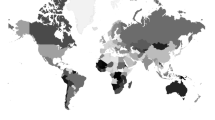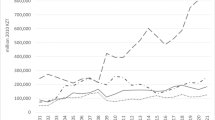Abstract
Throughout the history of its European settlement, Western Australia (WA) has derived great benefit during its mining boom periods. This was the case with the gold rushes of the late nineteenth and early twentieth centuries. It also occurred in the four decades after 1960 when the state became a major exporter of iron ore, alumina nickel, mineral sands, diamonds and natural gas to Japan, South Korea, Taiwan and other Asian economies as well as its more established production and export of gold into world markets. The present paper assesses developments in the period between 2004 and 2014 and beyond, as the Chinese economy emerged to become WA’s major mineral customer. In relation to other Australian states, it particularly reports on Western Australia’s economic growth rates, per capita GDP, housing price movements, unemployment and workforce participation rates. There is some consideration as well of the public debt challenges recently facing the state. These have been magnified by low levels of return of Goods and Services Tax revenue to Western Australia by the Commonwealth Grants Commission. This is a reflection of the de facto redistribution of WA mining royalties to the other Australian states.











Similar content being viewed by others
Notes
Almost 76,000 Aboriginal and Torres Strait Islanders lived in the state, with about 45,000 of them outside of Perth. Relatively larger groups of Indigenous peoples lived in the Kimberley and Pilbara regions in the north of the state.
More detailed estimates are available from the Department of Mines and Petroleum Western Australia (various years).
Australia changed its currency from the Australian pound (£A) to the Australian dollar ($A) in early 1966. At that time, one Australian pound exchanged for two new Australian dollars.
The Australian Government introduced this embargo in 1938.
Cashin uses data on monetary aggregates of the Australian colonies and New Zealand and assumes that the income velocity of each of the colonies equals that for Australia.
See Phillips (2016).
Venables (2016) provides an excellent recent review of the debate in this area.
Cashin uses Colonial Census data for the years of 1861, 1871, 1881 and 1891 and for the years 1901, 1911, 1921, 1933, 1947, 1954, 1961, 1971, 1981, 1986 and 1991.
Mining royalties are taxes on a company’s mine production measured in monetary units per unit of output (e.g. $5 per tonne) or as a percentage of the monetary value of a mine’s output (e.g. 5% of mine revenue)
References
Appleyard RT (1991) Western Australia into the twenty-first century: economic perspectives. St George Books, Perth
Australian Bureau of Statistics (2015) Australian National Accounts: State Accounts, Cat no. 5220.0. Canberra
Australian Bureau of Statistics (2016) Residential property price indexes: eight capital cities, Dec 2015, Cat no. 6416.0, Canberra
Australian Bureau of Statistics (b) various years, Yearbook of Western Australia, Perth: Australian Government
Australian Bureau of Statistics (c) various years, Mineral and petroleum exploration: Australia, Cat no. 8412.0, Canberra
Australian Bureau of Statistics (d) various years, Private New Capital Expenditure and Expected Expenditure: Australia, Cat no. 5625.0, Canberra
Auty RM (1993) Sustaining development in mineral economies: the resource curse thesis. London: Routledge
Battellino R (2010) Mining Booms and the Australian Economy. Reserve Bank of Australia Bulletin. March quarter, 63–69
Cashin P A (1993) Using data on money stocks to estimate real colonial GDP in the seven colonies of Australasia: 1861–1991, Center Discussion Paper No 687, Economic Growth Center, Yale University, May, 40p
Commonwealth of Australia (2017) Budget 2017–18: Federal Financial Relations Budget Paper No. 3, Canberra
Commsec (2017) various years, State of the States, (Downloaded from www.commsec.com.au/homepage.html)
Corden WM (1984) Booming sector and Dutch disease economics: survey and consolidation. Oxf Econ Pap 36:359–380
Corden WM (2012) Dutch disease in Australia: policy options for a three-speed economy. Aust Econ Rev 45(3):290–304
Corden WM, Neary JP (1982) Booming sector and de-industrialisation in a small open economy. Econ J 92(368):825–848
Davis GA (1995) Learning to love the Dutch disease: evidence from the mineral economies. World Dev 23(10):1765–1779
De Poloni, Glen (2013) Rents are up and down in the Pilbara. ABC News, (Downloaded from www.abc.net.au)
Department of Mines and Petroleum Western Australia, various years, Western Australian Minerals and Petroleum Statistics Digest, Perth. (Downloaded from www.dmp.wa.gov.au)
Downes P, Hanslow K, Tulip P (2014) The effect of the mining boom on the Australian economy. research discussion paper 2014–08. Reserve Bank of Australia, Sydney 44p
Gelb, Alan, Associates (1988) Oil windfalls: blessing or curse. World Bank, Washington
Government of Western Australia (2015a) 2015–16 Budget Paper No. 3 Economic and Fiscal Outlook, Perth. (Downloaded from www.ourstatebudget.wa.gov.au)
Government of Western Australia (2015b) 2015–16 Government Mid-year Financial Projections Statement (or Mid-year Review), Perth. (Downloaded from www.treasury.wa.gov.au)
Government of Western Australia (2017) various years, Western Australia Economic Profile, Department of State Development, Perth
Jackson T, Green K P, (2016) Fraser Institute Survey of Mining Companies, Vancouver
Maddison A (1995) Monitoring the World Economy, Organisation for European Co-operation and Development, Paris
Maxwell P (1999) The Importance of Mining Services to the Western Australian Economy. CEDA Information Paper No 63, December, 23p
Maxwell P, Guj P (eds) (2013) Mineral economics, Second edn. Australasian Institute of Mining and Metallurgy, Melbourne
Menzie D, Pui-Kwan T, Fenton M, Jorgenson J, van Oss H (2004) China’s growing appetite for minerals. United States Geological Survey, Open-File Report 2004–1374
Mining Minerals and Sustainable Development (2002) Final Report, International Institute for Environment and Development, London
O’Connor A (2017) WA Government grapples with budget crisis as it seeks return to surplus—but what can it do? ABC News, Australian Broadcasting Commission, 6 April 2017. Downloaded from www.abc.net.au on 7 May, 2017
Phillips K (2016) The mining boom that changed Australia. Downloaded from Radio National, Australian Broadcasting Corporation, 13 April
Radetzki M (2006) The anatomy of three commodity booms. Res Policy 31:56–64
Radetzki M (2008) A Handbook of Primary Commodities in the Global Economy, Cambridge University Press
Rolfe J, Miles B, Lockie S, Ivanova G (2007) Lessons from the social and economic impacts of mining of the mining boom in the Bowen Basin 2004–2006. Australas J Reg Stud 13(2):134–153
Sachs JD, Warner AM (1995) Natural resource abundance and economic growth. NBER Working Paper No. 5398, December
Venables AJ (2016) using natural resources for development: why has it proved so difficult? J Econ Perspect 30(1):161–184
Western Australian Treasury Corporation (2017). http://www.watc.wa.gov.au/. Accessed 5 May
Wiggins C (1993) Mining Services in Western Australia. CEDA Mining Program, Perth
Author information
Authors and Affiliations
Corresponding author
Additional information
The author thanks Bob Murphy for his comments on an earlier draft of this paper.
Appendix
Appendix
Rights and permissions
About this article
Cite this article
Maxwell, P. The end of the mining boom? A Western Australian perspective. Miner Econ 31, 153–170 (2018). https://doi.org/10.1007/s13563-017-0116-9
Received:
Accepted:
Published:
Issue Date:
DOI: https://doi.org/10.1007/s13563-017-0116-9




